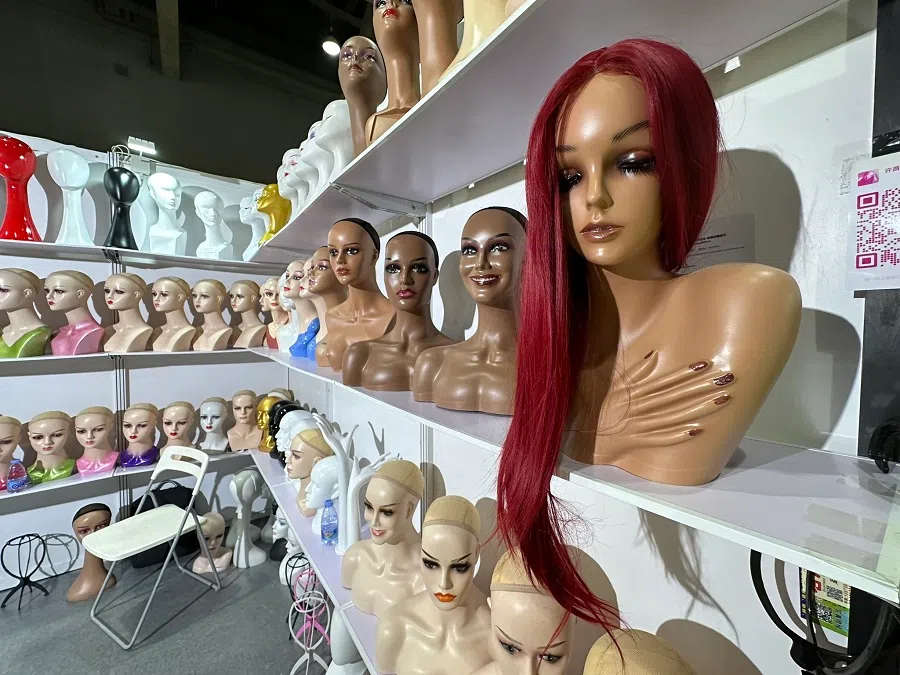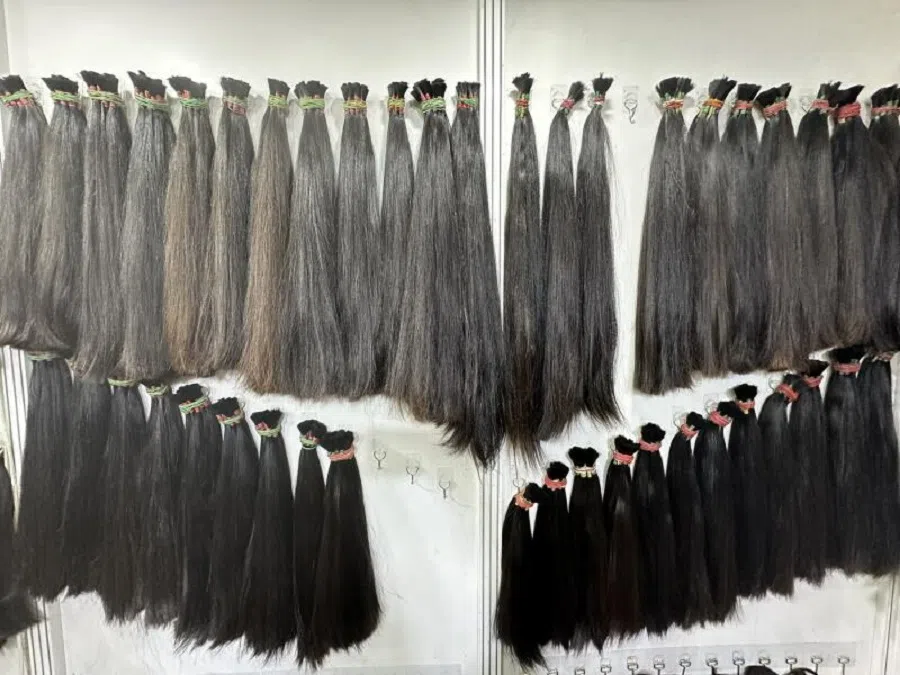[Big read] If China’s Xuchang city stopped producing wigs, many would be ‘a little bald’
Did you know that China’s wig industry mainly sources hair from young women in Yunnan, Guizhou and Sichuan? Premium human hair can fetch up to 30,000 RMB per kilogram, and many wigs are woven in North Korea before they are shipped globally. Lianhe Zaobao correspondent Daryl Lim learns more in Xuchang city, Henan province — the wig capital of the world.

“At least ten of my family members and friends are in the wig industry, the soul of our city.”
On hearing that I was doing interviews about the wig industry, my private hire driver Qu enthusiastically shared about his relatives and friends in the industry on our way to Shilipu in Xuchang.
Xuchang, a fourth-tier city in Henan province, recently went viral due to the Pang Dong Lai supermarket. However, Xuchang has long been renowned for its wig industry, which is a bright calling card and a pillar industry.
Thriving wig industry in Xuchang
Xuchang has a resident population of approximately 4.38 million, with over 300,000 people working in the wig industry. In other words, one in every 15 people makes a living from wigs.
China is the world’s largest hair product manufacturing base and exporter, accounting for 80% of the global market — Xuchang’s wig production occupies 60% of the global market. Qu joked that if Xuchang stopped production, many people around the world would become “a little bald”.
Xuchang’s wig-making history dates back to the Jiajing Emperor’s reign during the Ming dynasty, primarily for theatrical performances.

According to Chinese customs statistics, Xuchang’s import and export value for hair products in 2023 reached 19.69 billion RMB (US$2.8 billion), representing a 10% year-on-year increase and accounting for 72.6% of the city’s total trade volume. Exports reached 16.85 billion RMB, up 17.7% year-on-year.
Dates back to Ming dynasty
Historical records show that Xuchang’s wig-making history dates back to the Jiajing Emperor’s reign during the Ming dynasty, primarily for theatrical performances. By the end of the Qing dynasty, a Xuchang entrepreneur collaborated with a German merchant to establish a business collecting and processing hair for export to Europe. This spurred multiple villages to join the hair product industry, paving the way for Xuchang’s wig sector.
As Western countries’ demand for wigs grew, Xuchang developed a comprehensive industry chain, from raw material supply to original equipment manufacturer (OEM) business-to-business processing and sales, and began accepting international orders.
Over the past 20 years, Xuchang enterprises have focused on brand development and technological innovation, leveraging the internet and cross-border e-commerce platforms to penetrate the global market, cementing their position in the global wig industry.
Currently, Xuchang boasts over 4,000 hair product-related enterprises with over 3,000 product varieties, exporting to approximately 120 countries and regions. According to data from the Xuchang Municipal Bureau of Commerce, Xuchang wigs hold over 40% market share in Europe and the Americas, and over 70% market share in Africa.
The annual China Hair Fair held in Guangzhou also offers Xuchang entrepreneurs the opportunity to further tap into the global market and negotiate with international buyers. The event, established in 2006 and organised by the China Chamber Of Commerce For Import & Export Of Light Industrial Products & Arts-Crafts, attracts around 300 exhibitors each year, with Xuchang accounting for one-fifth of them.
The growth of cross-border e-commerce has boosted the prosperity of Xuchang’s wig industry. Wigs are small, light and easy to transport, which make them an ideal product for cross-border e-commerce.
At the recent fair held in early September, Sunny Jovani, purchasing manager of a Spanish chain of hair salons, told Lianhe Zaobao that pairing wigs with fashion has been extremely popular in Spain and Europe.
Sold globally through cross-border e-commerce
Jovani noted that in Europe and the US, long, wavy hair represents elegance. Among the nobility, wearing wigs is not only fashionable but also a symbol of status and taste. She said that Spain’s hair market has grown by over 10% annually since 2020, and the trend is growing, adding that the increasing demand for wigs has led to a rise in the number of companies selling hair products, indicating growing market demand.
In Africa, wigs are not only a fashion accessory but also a necessity. African hair generally grows slowly and is prone to tangling, making wigs a convenient solution for hair care and fashion.
According to Xinhua, China’s wig exports to West African countries such as Benin, South Africa, Nigeria and Ghana have seen steady growth in recent years. This is attributed to factors including strengthening China-Africa relations, expanding market demand, improved logistics efficiency, and the rapid development of e-commerce.

The growth of cross-border e-commerce has boosted the prosperity of Xuchang’s wig industry. Wigs are small, light and easy to transport, which make them an ideal product for cross-border e-commerce.
Data showed that over 90% of hair product businesses in Xuchang have expanded their international markets through cross-border e-commerce. On Alibaba’s AliExpress platform, there are more than 450 Xuchang-based hair product businesses, with a total annual transaction volume of US$300 million and an average of over 20,000 shipment orders daily.
South African wig businessman Bauer stated in an interview, “China’s e-commerce platforms are leading the pack globally. We can intuitively see the quality and style of the wigs through live streams. Some would even specially hire live models from our ethnic background to showcase the products, giving us more assurance when we make bulk orders.”
Wigs have even become an aspect of women’s fashion outfits. An increasing number of young men with hair loss issues have also begun to embrace the idea of wearing a wig to elevate their image.
Gradual rise in demand for wigs in China
Traditionally, China was not a key consumption market for wigs, but along with the change in consumer perception and the diversification of aesthetic preferences, the demand for wigs have climbed in recent years. A report by CCTV Finance in 2021 stated that China’s domestic wig market has grown 20% or more for six consecutive years.
In China, some youths have turned to wearing wigs to avoid repeatedly dyeing and perming their hair. Wigs have even become an aspect of women’s fashion outfits. An increasing number of young men with hair loss issues have also begun to embrace the idea of wearing a wig to elevate their image.
Along with the rising domestic demand for wigs, Xuchang also began to place more emphasis on the exhibition and sale of wigs. When I visited Xuchang in early September, I discovered a “wig street” set up just last year. The 100-metre pedestrian walkway was filled with over a dozen wig shops; each store displayed model heads donning hundreds of wigs across a range of hairstyles.

A salesperson said, “There would be a lot of footfall here every weekend. We have a wide variety of selection, something that other places cannot compete with.”
What makes a wig?
The price of human hair used for making wigs has risen rapidly in the past decade. Dubbed “black gold” by the industry, high-quality human hair can fetch up to 30,000 RMB per kilogram.
Wigs generally fall into two categories: chemical fibre wigs and wigs made with real hair. The former cost around hundreds of RMB, while the latter often cost more than 1,000 RMB or even more than 10,000 RM, as it has a smoother texture, more comfortable to wear and has a more realistic effect.
China’s wig industry mainly use hair of young females from the Yunnan, Guizhou and Sichuan region, as the quality of their hair is better...
Wig factories would recycle the hair of young females obtained from salons or professional traders as the base ingredient for their wigs, and separate them into different grades based on length, hair quality, colour and health.
Miao Miao, who is head of the Lai Yuan Wig Factory in Xuchang, told Lianhe Zaobao that China’s wig industry mainly use hair of young females from the Yunnan, Guizhou and Sichuan region, as the quality of their hair is better, making it easier for post-processing and maintenance over time.
She added, “The climate in these areas are gentler and more humid, so the locals have hair that is darker, thicker, smoother and shinier. This is in line with the expectations from the international market for the base material of wigs. Local females also traditionally keep their hair long, and this provides a stable supply of hair for the industry.”
Up to 30,000 RMB per kilogram, and woven in North Korea
Miao also stated that hair that has never been permed or dyed from young females is especially sought after by the industry, fetching the highest price. She said, “Human hair of such quality can fetch 10,000 to 30,000 RMB per kilogram, and the longer it is the more expensive it gets.”
The huge demand for wigs has led to the rising price for human hair over the past decade or so. Miao commented that 20 years ago, quality human hair cost a mere 3,000 to 4,000 RMB per kilogram; but the price has risen exponentially today, increasing most rapidly during the few years pre-pandemic.
Faced with persistently rising costs, the industry has begun to pivot towards recycling hair from South Asia and Southeast Asia as a means to drive costs down.
“80% of human hair wigs sold in China are woven in North Korea before being shipped back to Xuchang for processing and sale. Their workmanship is better and labour costs are lower too.” — Miao Miao, Head, Lai Yuan Wig Factory in Xuchang
After recycling hair, wig factories would further treat the hair — a tedious and complicated process involving at least ten steps including cleaning, trimming, separation by colour, weaving and shaping. The majority of the work is done manually, of which the most labour-intensive step would be hooking the strands of hair onto the mesh scalp cap.
Miao said that a person typically has 50,000 to 80,000 strands of hair, and a wig made fully with human hair requires 5,000 to 25,000 stitches. The wigmaker has to manually weave each strand of hair precisely onto the mesh cap while also adjusting the hooking angle to simulate the natural direction of hair growth.

Making a high-quality, fully hand-woven wig typically takes one to two months. With rising labour costs in China, many of the lower-end weaving jobs are gradually outsourced overseas.
Miao said, “80% of human hair wigs sold in China are woven in North Korea before being shipped back to Xuchang for processing and sale. Their workmanship is better and labour costs are lower too.”
Statistics from China’s General Administration of Customs show that 57% of goods imported by China from North Korea last year were wigs, totalling 1,821 tons, with an import value of 1.18 billion RMB.
Miao said that following advancements in wig-making techniques, the quality has also continued to improve. “If worn daily, a wig can last three to five years without any issues. A customer bought a hairpiece ten years ago and only came back to switch to a new one just before the Spring Festival this year. Of course, a wig’s lifespan also depends on how well the client maintains it,” she said.
Rebecca, cradle of Xuchang’s wig industry
It is difficult not to mention Rebecca (瑞贝卡) when talking about Xuchang’s wig industry. Known as the “first stock” of China’s wig industry, Rebecca is the cradle of several wigmakers in Xuchang’s wig industry, driving the sector’s growth in the area.

Established in 1993, Rebecca is one of the largest wig manufacturers in the world. It produces thousands of products and has a sales network spanning over 40 countries in North America, western Europe, Asia and Africa.
To the people of Xuchang, Rebecca is not only an important company with a global presence, but also a benchmark for the local wig industry. The six-kilometre “Rebecca Boulevard” (瑞贝卡大道) in Xuchang illustrates the significance of this enterprise in the area.
Several owners and employees of wig companies revealed that Rebecca was their starting point in the wig business. Miao started her career in wig processing at Rebecca when she first came to work in Xuchang two decades ago. As an industry leader, Rebecca has not only driven the development of the wig sector in the city but also provided a valuable starting point for many professionals in the field, Miao noted.
She said, “We gained valuable industry knowledge and professional skills over there, laying the foundation for us to either establish our own businesses or join other companies later on.”
Making cheaper better artificial hair
When it comes to nurtured talents jumping ship or becoming competitors, executives at Rebecca see this as an opportunity to drive the company forward, fostering continuous innovation and improvements in products and techniques.
The texture of protein fibres is comparable to human hair and can be mass produced. These new products are priced five to six times lower than human hair, making them extremely popular in the African market.” — Shen Peng, Cross-Border E-Commerce Sales Director, Rebecca

Shen Peng, a cross-border e-commerce sales director at Rebecca, said during an interview, “Rebecca’s future is unique and cannot be taken away, even though there are many wig companies in the world that can thrive in the market.”
Shen stressed that Rebecca values independent innovation and has over 200 members in its research and development team, as well as numerous research centres for hair products across the country. For example, Shen shared that the company has already anticipated the shortage of raw materials for wigs and rising costs several years ago, and has thus heavily invested in developing synthetic collagen fibres that mimic human hair.
He said, “Our research in this area has yielded significant results. The texture of protein fibres is comparable to human hair and can be mass produced. These new products are priced five to six times lower than human hair, making them extremely popular in the African market.”
Shen asserted that although many industry practitioners think that the wig industry has limited technical complexity and lacks room for innovation, each craft in fact has the potential for improvement and breakthroughs.
He said, “Whether it’s developing higher-quality materials or using artificial intelligence for wig customisation, the wig industry still has vast potential as long as the spirit of innovation stays alive.”
This article was first published in Lianhe Zaobao as “许昌假发 破解全球“秃头”难题”.




![[Big read] China’s 10 trillion RMB debt clean-up falls short](https://cassette.sphdigital.com.sg/image/thinkchina/d08cfc72b13782693c25f2fcbf886fa7673723efca260881e7086211b082e66c)
![[Big read] Love is hard to find for millions of rural Chinese men](https://cassette.sphdigital.com.sg/image/thinkchina/16fb62fbcf055b710e38d7679f82264ad682ce8b45542008afeb14d369a94399)